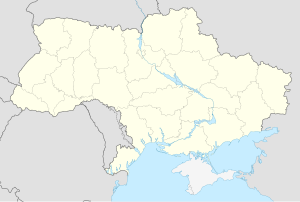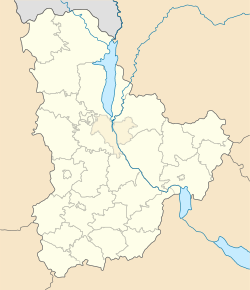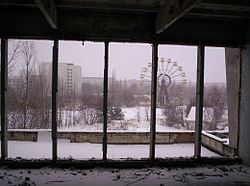Prypiat
From Wikipedia, the free encyclopedia
For other uses, see Pripyat.
| This article needs additional citations for verification. (May 2009) |
| Prypiat | |
|---|---|
| — Abandoned city — | |
| При́п'ять (Ukrainian) При́пять (Russian) | |
| Coordinates: 51°24′20″N 30°03′25″E | |
| Country | |
| Oblast | |
| Raion | |
| Founded | 1970 |
| City rights | 1980 |
| Government | |
| • Administration | State Agency of Ukraine on the Exclusion Zone Management |
| Population (2001) | |
| • Total | 0 |
| Time zone | EET (UTC+2) |
| • Summer (DST) | EEST (UTC+3) |
| Postal code | none |
| Area code(s) | +380 4499[1] |
Prypiat (Ukrainian: При́п'ять, Pryp’yat’; Russian: При́пять, Pripyat’) is a ghost town near theChernobyl Nuclear Power Plant, within the Chernobyl Exclusion Zone, part of Kiev Oblast(province) of northern Ukraine, near the border with Belarus.[2]
The city has a special status within the Kiev Oblast, being the city of oblast-level subordination (see Administrative divisions of Ukraine), although it is located within the limits of Ivankiv Raion. The city also is being supervised by the Ministry of Emergencies of Ukraineas part of the Zone of Alienation jurisdiction.
Pripyat was founded in 1970 to house workers for the Chernobyl Nuclear Power Plant. It was officially proclaimed a city in 1979 but was abandoned in 1986 following the Chernobyl disaster. It was the ninth nuclear city (Russian: атомоград atomograd) in the Soviet Union at the time and its population was around 50,000 before the accident[citation needed].
The annual rate of natural increase for the city's population was estimated at around 800 persons, plus over 500 newcomers from all corners of the Soviet Union each year;[citation needed] Pripyat's population had been expected to rise to 78,000. The Yanov railroad station (part of Chernigov-Ovruch railroad link) was less than 1 km away from the city, and the navigable Pripyat River flows nearby.
Contents[hide] |
[edit]Background
Access to Pripyat, unlike cities of military importance, was not restricted before the disaster as nuclear power stations were seen by the Soviet Union as safer than other types of power plants. Nuclear power stations were presented as being an achievement of Soviet engineering, where nuclear power was harnessed for peaceful projects. The slogan "peaceful atom" (Russian: мирный атом, mirnyj atom) was popular during those times. The original plan had been to build the plant only 25 km (16 mi) from Kiev, but the Ukrainian Academy of Sciences, among other bodies, expressed concern about it being too close to the city. As a result, the power station and Pripyat[3] were built at their current locations, about 100 km (62 mi) from Kiev. After the disaster the city of Pripyat was evacuated in two days.[4]
[edit]Development
Along with its prime goal as being home to nuclear power plant's employees, Pripyat had been viewed as a major railroad and river cargo port in northern Ukraine. The urban nomenclature was quite typical for the time. There were traditional ideological names on the city map such as Lenin Avenue, International Friendship Street, Heroes of Stalingrad Street, etc.
There also were some street names that had local bearings, e.g. Embankment Street, Builders Avenue, and Enthusiasts Avenue. Lesya Ukrainka Street has cultural implications: it bears the name of one of the greatest poets of Ukraine. The standard Soviet theme was also included in the naming scheme: Igor Kurchatov Street was named after the "Father of the Soviet Atomic Bomb".
Pripyat had a defined city centre where the city hall (or city council), the largest shopping centres, major recreational and public catering facilities and the Polissya hotel were located.
The chief idea behind the urban layout was the so-called triangular principle, developed by Moscow architects in the project run by the then famous Nicolay Ostozhenko. After adjustments by Kiev architects, the plan of the city's development was finally approved. At the time this triangular one-of-a-kind layout was unique, though by the time the building of Pripyat started it had been implemented in dozens of Soviet cities and the novelty soon wore off.[citation needed]
The triangular plan featured alternating five-story buildings and high-rises, with the city lined with broad vistas, open spaces, and the horizon visible from almost every corner. Unlike the old cities with their tiny yards and narrow streets, Pripyat had been initially planned to look free and vivid, all for the comfort of its inhabitants. Besides the calculated boost of street space, the goal had been achieved by making the streets and blocks symmetrical. Taken together, these solutions were intended to immunize Pripyat from such scourges of modern times as traffic jams.[citation needed]
[edit]Infrastructure and statistics
- Population: 49,400 before the disaster. The average age was about 26 years old. Total living space was 658,700 m2: 13,414 apartments in 160 apartment blocks, 18 halls of residence accommodating up to 7,621 single males or females, and 8 halls of residence for married or de facto couples.
- Education: 15 primary schools for about 5,000 children, 5 secondary schools, 1 professional school.
- Healthcare: 1 hospital that could accommodate up to 410 patients, and 3 clinics.
- Trade: 25 stores and malls; 27 cafes, cafeterias and restaurants could serve up to 5,535 customers simultaneously. 10 warehouses could hold 4,430 tons of goods.
- Culture: 3 facilities: a culture palace, a cinema and a school of arts, with 8 different societies.
- Sports: 10 gyms, 3 indoor swimming-pools, 10 shooting galleries, 2 stadiums.
- Recreation: 1 park, 35 playgrounds, 18,136 trees, 249,247 shrubs, 33,000 rose plants.[citation needed]
- Industry: 4 factories with total annual turnover of 477,000,000 rubles. 1 nuclear power plant.
- Transportation: Yanov railway station, 167 urban buses, plus the nuclear power plant car park of about 400 units.
- Telecommunication: 2,926 local phones managed by the Pripyat Phone Company, plus 1,950 phones owned by Chernobyl power station's administration, Jupiter plant and Department of Architecture and Urban Development.
[edit]Post-Chernobyl years
In 1986 the city of Slavutich was constructed to replace Pripyat. After the city of Chernobyl, this is the second-largest city for accommodating power plant workers and scientists in the Commonwealth of Independent States (CIS).
Many of the building interiors in Pripyat have been vandalised and ransacked over the years. Because the buildings have not been maintained since 1986, the roofs leak, and in the springtime the rooms are flooded with water. Trees can be seen growing on roofs and even inside the buildings. All this adds to the deterioration process; a four-story school collapsed in July 2005.
One notable landmark often featured in photographs of the city, video games (such as Call of Duty 4: Modern Warfare and the S.T.A.L.K.E.R. series) and visible from aerial-imaging websites such asGoogle Maps, is the long-abandoned ferris wheel located in the Pripyat amusement park.
[edit]Safety
A natural concern is whether it is safe to visit Prypiat and the surroundings. The Zone of Alienation is considered relatively safe to visit, and several Ukrainian companies offer guided tours around the area. The radiation levels have dropped considerably, compared to the fatal levels of April 1986, due to the decay of the short-lived isotopes released during the accident. In most places within the city, the level of radiation does not exceed an equivalent dose of 1 μSv (one microsievert) per hour.[citation needed]
The city and the Zone of Alienation are now bordered with guards and police, but obtaining the necessary documents to enter the zone is not considered particularly difficult. In 2005, New York-based entrepreneur David C. Haines founded a company to provide guided tours of the city. A guide accompanies visitors to ensure nothing is vandalised or taken from the zone.
The doors of most of the buildings are held open to reduce the risk to visitors, and almost all of them can be visited when accompanied by a guide. The city ofChernobyl, a few kilometers south from Pripyat, has some accommodation including a hotel, many apartment buildings, and a local lodge, which are maintained as a permanent residence for watch-standing crew and tourists.
[edit]Cultural references
- The city of Pripyat is the location of filming of the 2008 documentary White Horse.[5]
- The short film The Door was shot in 2008 in Pripyat.[6]
- The exclusion zone is the setting for Karl Schroeder's science fiction short story "The Dragon of Pripyat".
- Pripyat plays a very important role in the video games S.T.A.L.K.E.R.: Shadow of Chernobyl and its sequel S.T.A.L.K.E.R.: Call of Pripyat; in both the player is able to visit and explore various parts of the city.
- The novel Wolves Eat Dogs by Martin Cruz Smith uses Pripyat as the setting for an investigation by Arkady Renko
- Much of the James Rollins novel The Last Oracle takes place in Pripyat and around Chernobyl. The story revolves around a team of American "Killer Scientist" special agents who must stop a terrorist plot to unleash the radiation of Lake Karachay on the world during the installation of the newsarcophagus over the Chernobyl nuclear power plant.
- The city is also the setting for two missions in Call of Duty 4: Modern Warfare based around the main square and the amusement park, set after the disaster. Also the multiplayer maps "Bloc" and "Vacant" in the game take place in Pripyat. A small part of the city is seen briefly in a flashback in Call of Duty: Modern Warfare 3, and the multiplayer map "Fallen" takes place in Pripyat. Call of Duty: Black Ops features a map called "Grid", which takes place in Pripyat. A level in Call of Duty: Modern Warfare 2 and a multiplayer map called "Wasteland" takes place in Pripyat and near Chernobyl, respectively.
- The American paranormal investigation series Destination Truth conducted an overnight investigation within Pripyat.
- The Northern Irish alternative rock band Ash have a track called "Pripyat" on their 2010 singles collection A–Z Vol. 1.
- The beginning of the 2011 movie Transformers: Dark of the Moon takes place at Pripyat.
- The PBS documentary Radioactive Wolves analyzes and compares the health of wildlife within and without the Exclusion Zone.
- The song "Dead City" (Ukrainian: Мертве Місто) by Ukrainian Symphonic Metal band DELIA is about Pripyat, and scenes from the music video were shot in the city. DELIA's vocalist, Anastasia Sverkunova, was born in Pripyat just before the Chernobyl disaster.[7]
- The 2012 horror movie Chernobyl Diaries was inspired by the Chernobyl Disaster in 1986 and takes place in Pripyat.[8]
[edit]Evacuation note, April 27, 1986
| This section may contain original research. (April 2012) |
"For the attention of the residents of Pripyat! The City Council informs you that due to the accident at Chernobyl Power Station in the city of Pripyat the radioactive conditions in the vicinity are deteriorating. The Communist Party, its officials and the armed forces are taking necessary steps to combat this. Nevertheless, with the view to keep people as safe and healthy as possible, the children being top priority, we need to temporarily evacuate the citizens in the nearest towns of Kiev Oblast. For these reasons, starting from April 27, 1986 2 p.m. each apartment block will be able to have a bus at its disposal, supervised by the police and the city officials. It is highly advisable to take your documents, some vital personal belongings and a certain amount of food, just in case, with you. The senior executives of public and industrial facilities of the city has decided on the list of employees needed to stay in Pripyat to maintain these facilities in a good working order. All the houses will be guarded by the police during the evacuation period. Comrades, leaving your residences temporarily please make sure you have turned off the lights, electrical equipment and water off and shut the windows. Please keep calm and orderly in the process of this short-term evacuation."









No comments:
Post a Comment